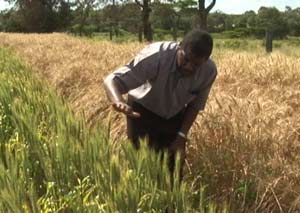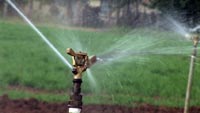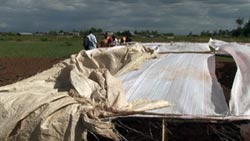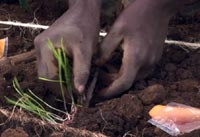CIMMYT E-News, vol 4 no. 2, February 2007
 At an agricultural research station in Kenya, ingenuity, improvised tools, and a small group of talented, dedicated researchers and technicians using good science, are on the front line of the battle to prevent a potential multi-billion dollar crop disaster for the world.
At an agricultural research station in Kenya, ingenuity, improvised tools, and a small group of talented, dedicated researchers and technicians using good science, are on the front line of the battle to prevent a potential multi-billion dollar crop disaster for the world.
Peter Njau has a look of concern on his face and a sense of urgency in his voice. “Be very gentle,” he says. “You don’t have to separate each seedling from the others.” Njau, KARI-Njoro’s wheat breeder, is teaching technicians at the Njoro Agriculture Research Centre of the Kenya Agricultural Research Institute (KARI) to transplant thousands of extremely delicate winter wheat seedlings. The seedlings have been kept in a cool environment to simulate a temperate winter and now they are ready for what they will interpret as springtime.

The technicians are using a new transplanting method for the very first time. It should be more efficient but the team only has one chance to get it right. All day they have been preparing the plot, wetting it down and cooling the soil using a new sprinkler irrigation system; making small furrows in the damp soil and putting in beads of fertilizer; carefully marking and labeling the location for each plant. The transplanting has to take place just before sunset so the seedlings will have cool soil and a cool night to start establishing their young root systems. Any mistake and they will die and the opportunity to test them for resistance to the new stem rust will be lost until the next season.
Speed and precision are vital since the airborne fungus that was discovered in Uganda in 1999 has now spread beyond the African continent. It is following a path that will take it to the great wheat growing areas of south Asia where farmers grow wheat eaten by a billion people. In the last great stem rust outbreak in North America in 1954, the fungus destroyed as much as 40% of the spring wheat crop.
The Njoro station is in the Great Rift Valley of Kenya, not far from the city of Nakuru and very close to the Equator. The new stem rust spores have been present in the air at the station for at least three years, making it the perfect location for testing wheat to see if it can resist the fungus. Called Ug99, the new stem rust is such a large threat to wheat around the world that scientists dare not transport the spores themselves to other test locations. Instead as part of the CIMMYT-ICARDA Global Rust Initiative, which also includes national partners like KARI and the Ethiopian Institute of Agriculture Research (EIAR), the world’s wheat comes to East Africa. Similar work is being conducted at several sites in Ethiopia by EIAR. “We are committed to work with international partners to fight the looming threat of stem rust,” says Dr. Bedada Girma, leader of EIAR’s Stem Rust Task Force.
Njau works for KARI and manages both his KARI assigned research as well as the GRI wheat nurseries (plots of different wheat plants) at the station. In one area the team grows three different kinds of wheat that are known to be easily infected with Ug99. The three wheats mature at different times so there is always a source of infection to challenge the wheat being tested. An adjacent field has over 3,000 samples of spring wheat in nurseries designed to confirm what appears to be resistances found in previous seasons. Those nurseries also include CIMMYT and KARI breeding populations from which breeders hope to extract high performance, Ug99 varieties for Kenya and the world.

Not far from the plots, inside a small building, sheets of polyethylene shroud a makeshift innoculum chamber. Plastic garbage bags act as blinds to keep the room dark. On the floor are two old plastic spray bottles for water to keep the leaves of the host wheat plants damp. It is here where the fungus is grown and multiplied for use later on test plants. “We improvise a lot here,” says Miriam Kinyua, the Director of the station and overall coordinator of Kenya wheat research, including GRI activities. “The world needs this work to be done.” She also expresses gratitude to the Canadian International Development Agency for providing funding that let the station put in a good irrigation system. “We can now grow wheat in the off season and ensure that if the rains fail, our testing won’t,” she says. She is also pleased that the research station is now connected to the rest of the world via a satellite dish and the internet, another result of the CIDA contribution. New contributions from USAID are adding to the support for GRI work in both Kenya and Ethiopia.

Back at the transplant plot each group of seedlings is hand watered. Early the next morning the team will put small tree branches in the ground around the plot as stakes to hold up some old canvas sheets. The canvas will shade the fragile seedlings from the hot equatorial sun for another three days. Perhaps under the flapping canvas is a seedling that holds the key to durable resistance to the Ug99 fungus.
For more information Rick Ward, Coordinator, Global Rust Initiative (r.w.ward@cgiar.org)
 Climate adaptation and mitigation
Climate adaptation and mitigation 
